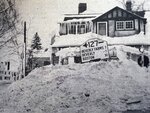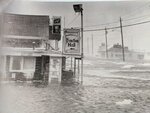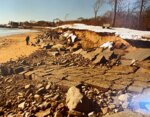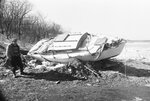




IN LATE JANUARY 1978, New England was digging out from the remnants of an historic winter storm that buried parts of the Ohio Valley and Upper Midwest in 30 to 50 inches of snow. It was known nationally as the Great Blizzard of 1978, and it dumped nearly three feet on Cape Ann.
Just two weeks later, three huge weather systems converged off the Atlantic coast, creating one gigantic swirl that enveloped much of the eastern seaboard. A new moon brought astronomical high tides and churned an immeasurable amount of moisture. The result? A supersized nor’easter of epic proportions that was New England’s worst storm of the 20th Century.
Monday morning, February 6 started typically enough for the work and school week. Snow had been predicted overnight, but by daybreak, hardly a flurry fell. Folks chalked up the blown forecast to know-it-all weathermen whose predictions were wrong—again.
By midday— as if in a flash—windswept snowflakes fluttered suddenly and violently in all directions. No one was prepared. Snow totals began to build and gale-force winds led to dangerous drifting. Governor Michael Dukakis urged schools and major employers to send everyone home early. But plow trucks couldn’t keep up; many broke down and were abandoned in snowbanks. Entire swaths of roadways disappeared. Guardrails and street signs were swallowed whole. Endless streams of commuters became hopelessly stuck in rush hour traffic with zero visibility and no way out.
To make matters worse, the storm stalled, gaining hurricane strength and pounding the region with whiteout conditions for 33 straight hours. Over 40 inches fell on parts of Cape Ann—a record. Some storekeepers and gallery owners in the four communities had to sleep in their shops overnight. Unsurprisingly, so did nurses at Addison Gilbert Hospital.
But what separated the Blizzard of ‘78 from other winter catastrophes here, was the relentless storm surge. Seas reaching 30-40 feet slammed the coast through four high tide cycles, flooding and flash freezing between day and night.
The Essex Causeway sat in four feet of water from Main Street to Eastern Avenue. The lot behind Manchester’s Town Hall could only be navigated by dinghy. Gloucester’s Blynman Canal was overcome; cresting over the Newell Stadium concession stand and rushing over Stacy Boulevard to Pavilion Beach. The Good Harbor Beach footbridge didn’t stand a chance. And everything from lobster gear to cars was strewn across T-Wharf and Bearskin Neck in Rockport.
Sea walls around Cape Ann were demolished. Fifty-foot-wide sections of Lane’s Cove’s granite barrier blew apart.
In Manchester, there was nothing left to protect Singing Beach, White Beach, or Black Beach. The pier at Masconomo Park broke off and floated away, as did the walkway at Tuck’s Point. Rockport’s Front and Back beaches practically disappeared.
Coastal homes, hotels, and fish shacks were literally picked up, moved, smashed or split in half from Long Beach to Pigeon Cove to Folly Cove. The most iconic building to perish was Rockport’s Motif #1, the lobster red fishing shed made famous by plein air artists who painted it more than any other building in the country.
The next day, the blizzard raged on, and just before noon, Motif #1 gave out from under itself and slumped into Rockport Harbor, where it rested on the dragger, Calypso. When the boat was freed, the building dropped, broke to pieces, and floated in the harbor for days. Dozens of locals salvaged pieces out of the water for momentos.
But the loss of Motif #1 paled in comparison to the tragedy that took place offshore. A huge oil tanker named Global Hope ran aground off Salem. Back at Gloucester’s Inner Harbor, experienced Skipper Frank Quirk, readied his 47-foot pilot boat, Can Do, to rescue the tanker’s 32 crewmen. Quirk was a celebrated hero in Gloucester, having received the city’s highest honor, the Mariner’s Medal, twice for countless rescue efforts at sea. Though Quirk wanted to reach the Global Hope alone, four others insisted on joining; marina operator Donald Wilkinson, electrician and boater Norman “David” Curley, restauranter and commercial fisherman Kenneth Fuller, and retired marine and Coast Guardsman, Charles Bucko.
They left shortly after dark during the height of the storm. Two hours later, Quirk, using a hand radio, relayed that the Can Do had lost its radar and had its windshield blasted out. He was concussed and bleeding. They were somewhere near Magnolia, having turned around at Baker’s Island. People who heard the boat was in trouble drove to the Beverly-Salem Bridge, Singing Beach and Magnolia Pier to aim their headlights at the ocean to guide the Can Do. Crewmen stuffed mattresses in the windows to block rushing seawater and desperately tried to restart the engine. It was two hours before dawn. That was the last communication from the vessel. Days later, Quirk, Wilkinson, Curley and Fuller washed ashore on neighboring beaches, as did wreckage from the Can Do. Bucko was found in the engine room.
When the storm finally passed, the region was in shambles. Every beach in Massachusetts was transformed. Many were without heat, power or running water. Ice downed power lines and trees, further hampering recovery efforts. Thousands had been stranded on roads and public transit systems, and 14 people died on Interstate 95 when mountainous snow drifts trapped exhaust fumes inside idling vehicles. Volunteers on skis and snowmobiles helped emergency personnel evacuate victims.
Governor Dukakis shut down highways, trains, and air travel. The entire week was declared a legal holiday so the state could clean up. With Route 128 shut down, mail service was canceled, and stores quickly ran out of bread and milk. National Guard troops arrived from Fort Bragg and Fort Devens. Snow was hauled to nearby harbors and dumped.
In all, 100 people in the Northeast were killed and nearly 5,000 injured. In today’s terms, the storm caused over $2 billion in damage. Because of the Blizzard of ‘78, precautionary travel bans and faster coastal evacuations are now the norm. These lessons, coupled with modern telecommunications and meteorology, have citizens, public safety officials, and first responders better equipped to deal with extreme weather.
Recovery on Cape Ann took weeks. The last of the snow didn’t melt until late spring.
Since the Blizzard of ‘78, we’ve endured similar snowfalls, ferocious floods and perfect disasters. But no weather event has ever left its lasting mark on Cape Ann quite like the “Storm of the Century.”
Kory Curcuru authors “Timeline” series for 1623 Studios.